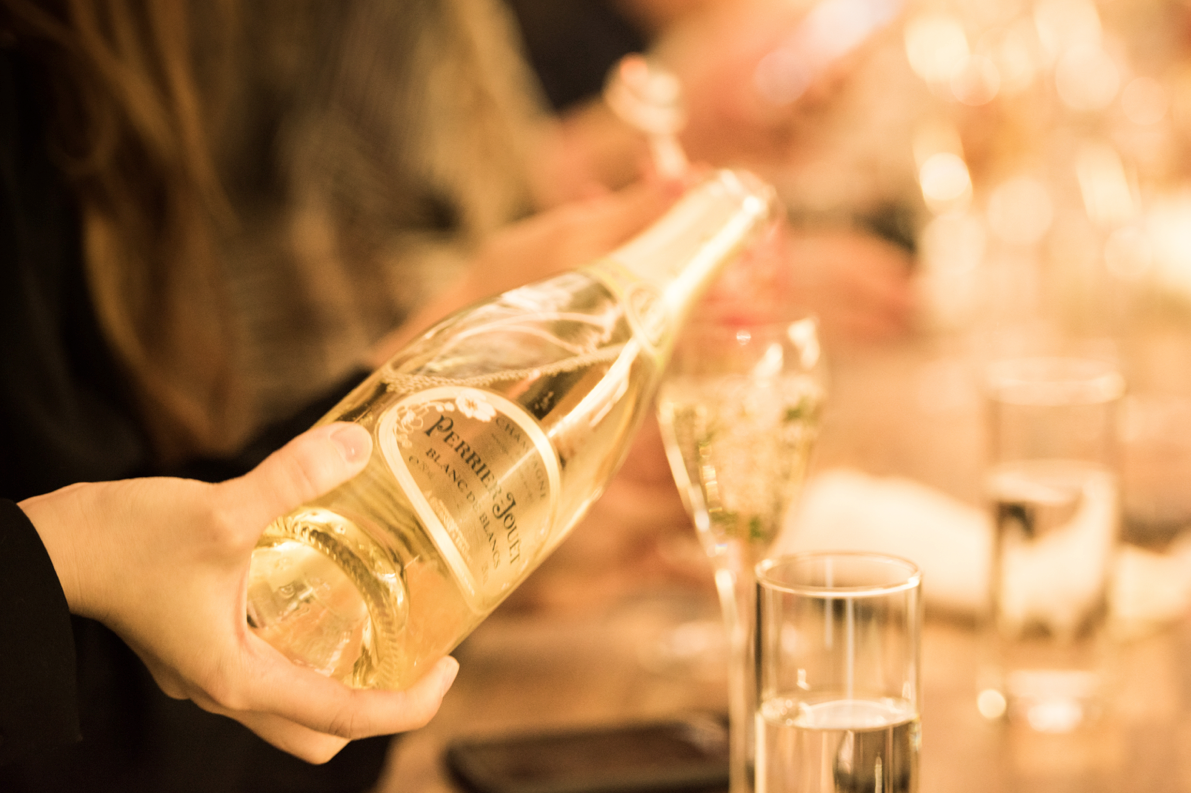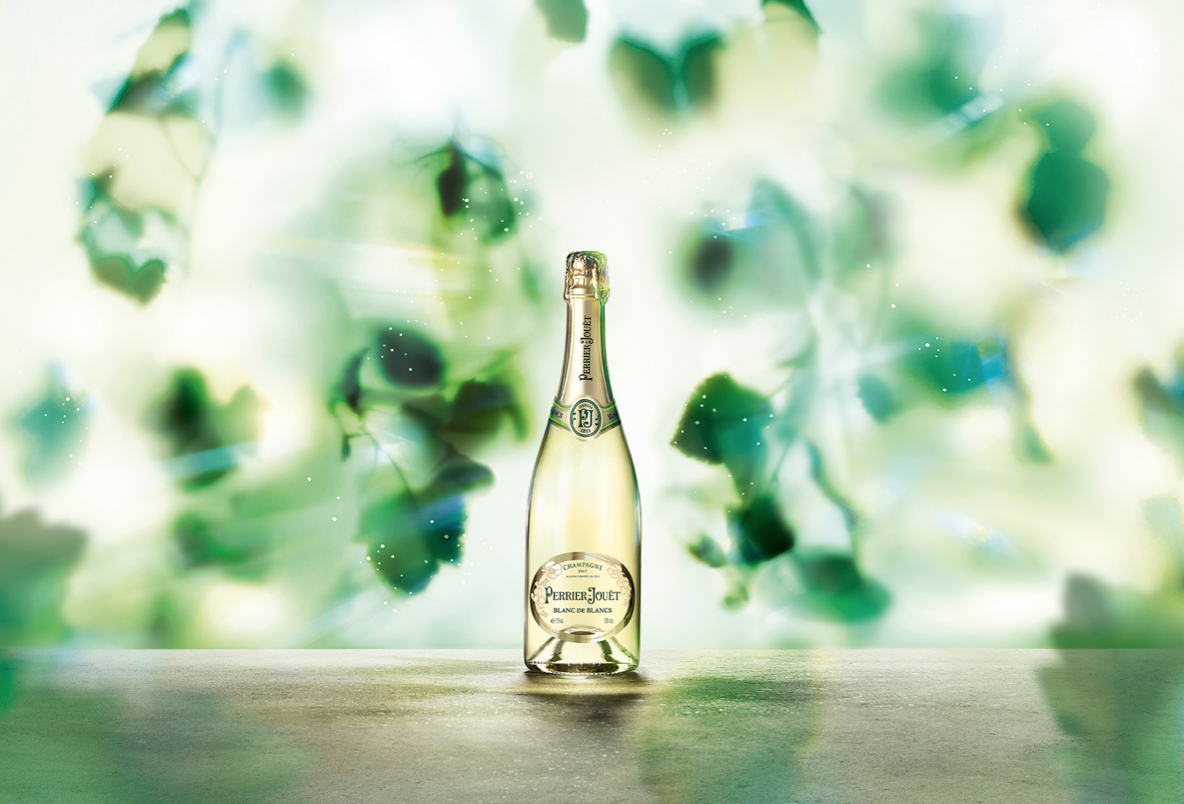While some champagnes are made for mass consumption, others speak directly to wine insiders. This is the case of the Blanc de Blancs (French for “white from whites”), the wine of choice among genuine oenophiles, which unlike most champagnes that are a blend of Pinot Noir, Pinot Meunier and Chardonnay, is crafted entirely from white grapes. Particularly enamoured with this under-the-radar bubbly filled with elegance, lightness, subtlety and finesse, Perrier-Jouët places it in the upper range of its portfolio. Holding the international launch of its first non-vintage Blanc de Blancs in Tokyo last April, it initiated a first-time collaboration with Paris-based Michelin-starred chef Akrame Benallal – who has restaurants in Paris, Hong Kong, Manila and Baku – to show how the champagne pairs particularly well with food, and invited French digital and virtual art pioneer Miguel Chevalier to demonstrate its strong contemporary art links. All this within a concrete gallery space that it transformed into a lush garden – a multi-sensory brand experience called “L’Eden by Perrier-Jouët” that expresses all the house’s facets through the décor, tastings, masterclasses and talks – while the room below recreated its hidden underground cellars in Épernay storing its top vintages.
Perrier-Jouët is known for its distinctive floral signature, and the new limited-quantity cuvée in a transparent bottle reveals the mineral freshness, vivacity and purity of the Chardonnay grape. Crafted by Hervé Deschamps – just the seventh cellar master in the brand’s 206-year history – who blended Chardonnays from the region’s finest terroirs, starting with a 2013 vintage and adding up to 15 per cent of reserve wines and a light dosage of 8g per litre, then left it to age for three years, the champagne boasts elderberry, acacia, honeysuckle and grapefruit aromas. It paired seamlessly with Benallal’s original tasting menu comprising surprising and audacious flavour combinations with dishes like sea urchin, mimolette and parmesan on rice paper, raw tuna with fresh mustard seeds, beer and lemon, beef with cocoa butter and beetroot, and avocado crème brûlée with pistachio.
Why hold the launch in Tokyo? Japan just so happens to be Perrier-Jouët’s biggest market, followed by the US. Global Marketing Director, Charles-Armand de Belenet, explains, “Japan has been our primary market for over 10 years. In the past, it was close between the US and Japan, but now the Japanese economy is doing quite well and the champagne market is doing very well. Perrier-Jouët and Japan share values of craftsmanship and a passion for nature. In terms of taste, Japanese consumers like Burgundy wines, especially white wines, and Chardonnay is fully in line with this. Food pairing is also key because champagne fits perfectly with the sophistication of Japanese cuisine and especially with fish. They also like that we are a boutique brand with limited production and very specific know-how.”
He describes the different global markets, “In Japan, it’s really about discerning consumers looking for know-how, history and tradition, whereas in the US, they’re more extroverted – they’re looking for fantastic products, but the main objective is to enjoy, high-energy celebration. In Asia, we see a big trend where consumers are increasingly looking for sophisticated products. They want to understand what they’re drinking and eating and to be 100 per cent convinced by the quality, tradition and know-how. In the past, Japan was really the best market in terms of expertise, but now we see it in cities like Hong Kong, Shanghai and Seoul. Consumers want to celebrate, but they want to do it with the best products, so they are more and more demanding.”
Art is at the heart of Perrier-Jouët. Chevalier’s “Extra Natural” interactive mural used the latest technologies to create a colourful virtual garden where plants incline to the left or right as if swaying in the wind, or petals and leaves fall, according to visitors’ spatial movements. The Mexican-born artist’s experimental, multidisciplinary oeuvre reconfigures references to art history using computer tools, examining recurrent themes such as nature and artifice, flows and networks, virtual cities and ornate designs. Obsessed by the question of the hybrid, generative and interactive image since the 1980s, he has conceived large-scale virtual reality installations and 3D-printed or laser-cut, holographic sculptures.
Perrier-Jouët’s link with artists is legitimate, as it has had longstanding ties with the art world, ever since 1902 when Art Nouveau artist Emile Gallé created the Japanese anemone design for the house’s Belle Époque prestige cuvée bottle, and it owns the world’s largest private collection of Art Nouveau pieces. The international style fusing art and nature is characterised by curvilinear motifs often derived from plants and flowers. The brand thus reinterprets its Art Nouveau legacy for the 21st century by commissioning work from established and emerging artists including Daniel Arsham, Noé Duchaufour-Lawrance, Makoto Azuma, Tord Boontje, Simon Heijdens, Tord Boontje, Vik Muniz, Mischer’traxler, Ritsue Mishima and Andrew Kudless.
Creative Director, Axelle de Buffevent, remarks, “Perrier-Jouët has roots in art and I want to make sure it’s not just looking back. We want to keep building the house’s heritage around the three key pillars of wine, nature and art for future generations. We inherited a beautiful story. We have to keep it alive and ensure that dialogue between historical and contemporary Art Nouveau. We choose artists according to the four criteria of Art Nouveau. That’s what makes them all relevant to us. We don’t pick artists who wouldn’t fit that philosophy, which makes it super specific to the house. It’s about adding beauty to everyday life, and Miguel did it in an amazing way. It’s about craft; what’s interesting to us about digital art is that it’s the 21st-century way of crafting things.” She insists that the selection of a digital artist wasn’t a conscious strategy of attracting younger, tech-savvy consumers, “Whatever medium the artist chooses, it’s about today’s way of thinking and creating. It’s not about pastiche. It’s about creating a dialogue between today’s creative people and heritage. The historical Art Nouveau artists were pioneers of their time, and Miguel is a pioneer. He started doing digital art in the 1980s when none of us knew about computers.”
Apart from supporting contemporary art, the end game is still to make the brand more widely known among different consumers. By combining the strengths of two separate universes and the distinct perceived properties associated with them, Perrier-Jouët is creating marketing synergy – is the aim to increase the premium consumers are willing to pay? Press & PR Director, Raphaëla Allouche, replies, “Art and champagne are really a part of the French art de vivre. We like to associate both because the family has always been close to artists. Art is a way to embody our brand DNA in another universe. We have noticed that people really understand the link. It’s true that associating our champagne to an artistic platform gives value to our positioning, but it’s not only to attract customers or a marketing strategy; it’s really part of our heritage.”
For the latest stories on food and wine, click here



















 Back
Back
